It’s no secret that playing the electric guitar can be an expensive hobby. The good news is that if you’re on a beginner or on a tight budget there are still some great amps at a fairly reasonable price. For instance, some brands and manufacturers are making electric guitar amps that are below the $100 mark. Yeah, as strange as it may sound, these things actually exist.
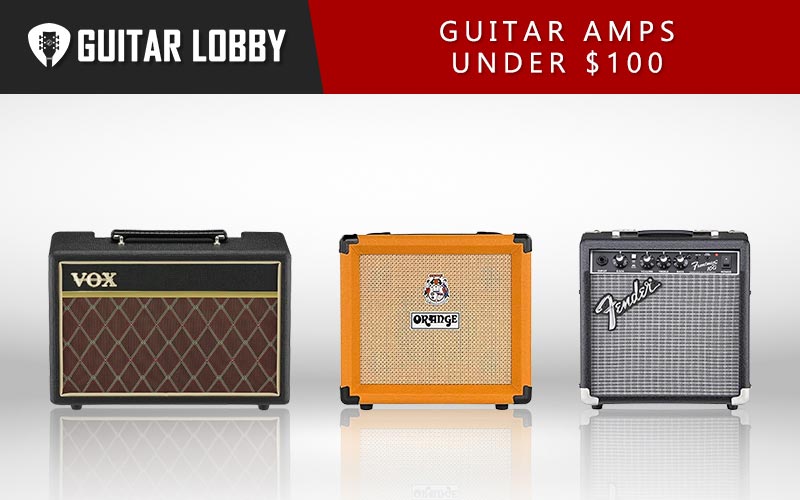
However, you need to bear in mind that these aren’t exactly your highly desired pro-level amps. Below the $100 mark, you’ll get a pretty decent practice amp with all of the required functionalities.
Sure, you can’t really expect a full-stack Marshall in this price range. But at the same time, there are a few amp models out there that cover the criteria and that you can potentially use for a smaller live gig. Therefore, we can definitely find some highly functional amps that outperform their price tag.
With all this in mind, we’ve decided to bring you the best guitar amps under 100 dollars. Know that this wasn’t exactly the easiest task. Firstly, there aren’t that many amps within this price level. And secondly, you have to go through most of the stuff to find stuff that’s actually worth your time.
| Name of Product | Image of Product | Description | Price Range | Full Review |
|---|---|---|---|---|
| 1. Boss Katana Mini (Editor's Choice) | 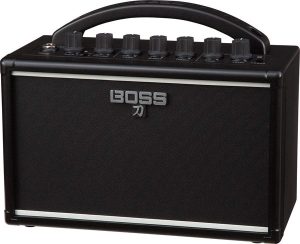 | Connectivity: 1 x ¼-inch guitar input, 1 x 1/8-inch aux input, 1 x 1/8-inch headphone output Output Power: 7 watts | $100 | Read Full Review Below |
| 2. Fender Frontman 10G (Most Popular) | 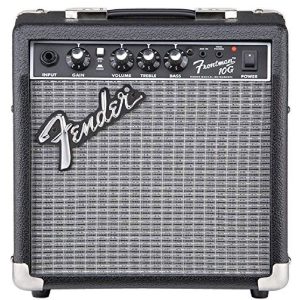 | Connectivity: 1 x ¼-inch guitar input, 1 x 1/8-inch aux input, 1 x 1/8-inch headphone output Output Power: 10 watts | $90 | Read Full Review Below |
| 3. Blackstar Fly 3 | 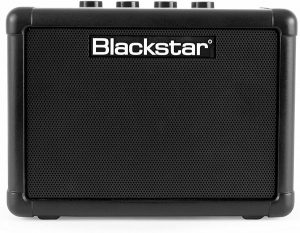 | Connectivity: 1 x ¼-inch guitar input, 1 x 1/8-inch aux input, 1 x 1/8-inch headphone output, 1 x RJ45 jack Output Power: 3 watts | $80 | Read Full Review Below |
| 4. Orange Crush 12 | 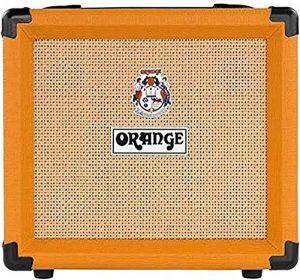 | Connectivity: 1 x ¼-inch instrument input, 1 x ¼-inch headphone output Output Power: 12 watts | $100 | Read Full Review Below |
| 5. Vox Pathfinder 10 | 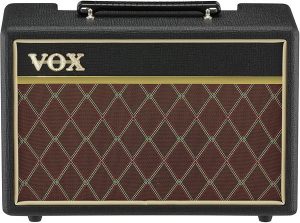 | Connectivity: 1 x ¼-inch instrument input, 1 x ¼-inch headphone/line output Output Power: 10 watts | $80 | Read Full Review Below |
| 6. Danelectro N-10 Honeytone | 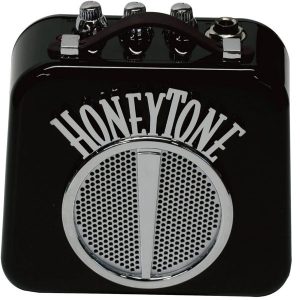 | Connectivity: 1 x ¼-inch instrument input, 1/8-inch headphone output Output Power: 1.5 watts | $30 | Read Full Review Below |
| 7. Monoprice 611720 | 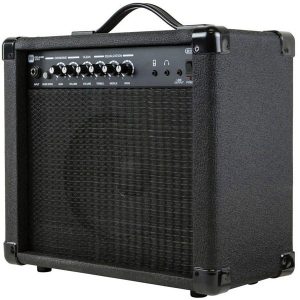 | Connectivity: 1 x ¼-inch instrument input, 1/8-inch aux input, 1/8-inch headphone output, 1/8-inch line output Output Power: 20 watts | $85 | Read Full Review Below |
| 8. Peavey Backstage II | 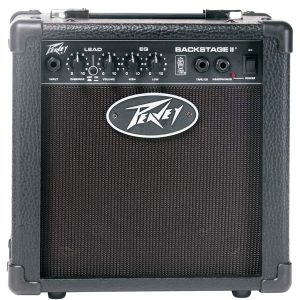 | Connectivity: 1 x ¼-inch instrument input, 1 x ¼-inch aux input, 1 x ¼-inch headphone output Output Power: 10 watts | $80 | Read Full Review Below |
| 9. Donner M-3 | 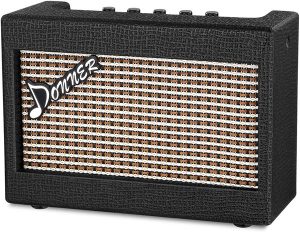 | Connectivity: 1 x ¼-inch instrument input, 1 x 1/8-inch aux input, 1 x 1/8-inch headphone output Output Power: 3 watts | $50 | Read Full Review Below |
| 10. Fender MD-20 Mini Deluxe | 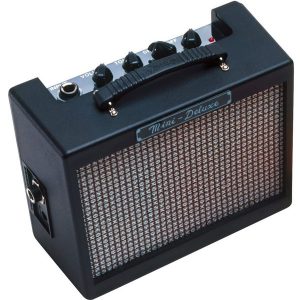 | Connectivity: 1 x ¼-inch instrument input Output Power: 2 watts | $45 | Read Full Review Below |
| 11. Orange Crush Mini | 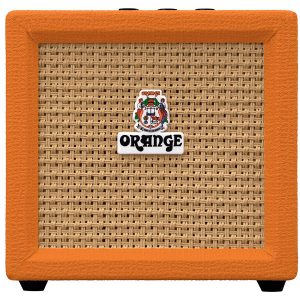 | Connectivity: 1 x ¼-inch instrument input, 1 x 1/8-inch headphone output Output Power: 3 watts | $60 | Read Full Review Below |
| 12. LyxPro AGL-20 | 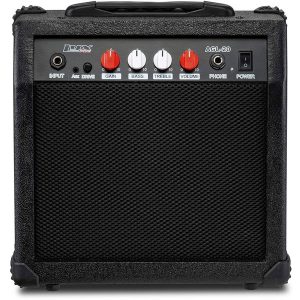 | Connectivity: 1 x ¼-inch instrument input, 1 x ¼-inch headphone output, 1 x 1/8-inch auxiliary input Output Power: 20 watts | $55 | Read Full Review Below |
| 13. Joyo Audio MA-10E | 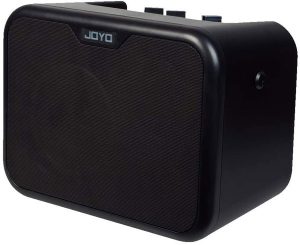 | Connectivity: 1 x ¼-inch instrument input, 1 x 1/8-inch headphone output, 1 x 1/8-inch auxiliary input Output Power: 10 watts | $45 | Read Full Review Below |
| 14. Sawtooth 10-Watt Amp | 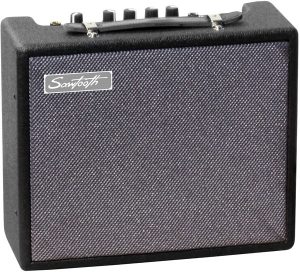 | Connectivity: 1 x ¼-inch instrument input, 1 x ¼-inch headphone output Output Power: 10 watts | $60 | Read Full Review Below |
Here Are the 14 Best Guitar Amps Under $100
1. Boss Katana Mini (Editor’s Choice)
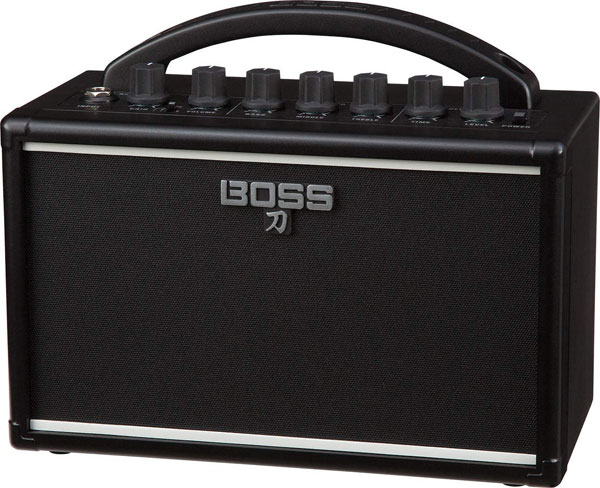
| Estimated Price | $100 |
| Connectivity | 1 x ¼-inch guitar input, 1 x 1/8-inch aux input, 1 x 1/8-inch headphone output |
| Output Power | 7 watts |
| Speaker | 1 x 4-inch |
My Review: Honestly, when Boss released their Katana series of amps, the whole guitar world was turned upside-down. No one could have expected that solid-state amps would sound so awesome.
If you ask me, they’ve easily achieved the quality that Roland’s legendary Jazz Chorus series did back in the day. Sure, an amp by Boss wasn’t expected. But the quality that they have with their pedals is present here as well.
And the same thing could be said about even the smallest and cheapest in the series, the Katana Mini. This potent little beast holds a total output power of 7 watts. Sure, it’s not much, but it really brings a solid tone with its 4-inch speaker.
While we’re at it, the amp comes with three basic “models.” Sure, there’s technically one channel on it (it’s not like you’d need more with such a small amp anyway), but there are “clean,” “crunch,” and “brown” modes. Aside from sparkling cleans, it can deliver interesting bluesy tones on the second setting, as well as some surprisingly heavy tones with the “brown” setting.
Other than that, the amp comes with a standard 3-band equalizer. Next to it, on the right-hand side, you can find the delay effect controls. There are only “level” and “time” parameters, which makes it somewhat limiting. But you can’t really ask for more on such a small and cheap amp.
Besides, having a delay effect on a small practice amp is a more than welcome addition. Plus, having fewer controls makes it really easy to use.
Aside from the regular ¼-inch instrument input, the amp comes with an auxiliary 1/8-inch input for various sources. While not obligatory to have one, it’s certainly a welcome addition.
But what makes it really interesting is the 1/8-inch headphone output. And it’s not just your regular output, but it features an actual cabinet simulator. This means that you can plug it into, let’s say, your home entertainment system or a PA system, and it will have that genuine micked-up amp kind of tone.
Finally, it’s also worth noting that the amp can be powered using six AA batteries. This way, it brings up to about seven hours of operation at an average volume level. Other than that, you can use it with a 9-volt adapter.
Bottom Line: I’d honestly say that this is the best amp within this price category. To be fair, I’m not certain whether you’ll find anything that matches its qualities with the price.
The best part is that this is a “universal” amp in the sense of who’s using it. Anyone from absolute beginners to full-blown pros – the Katana Mini brings you the best possible tones for practice sessions and pre-performance warmups.
The cabinet simulation is pretty awesome as well. If you’re feeling bold enough, you can try and plug it into a PA system and see whether you can get some genuine tones for live gigs.
2. Fender Frontman 10G (Most Popular)
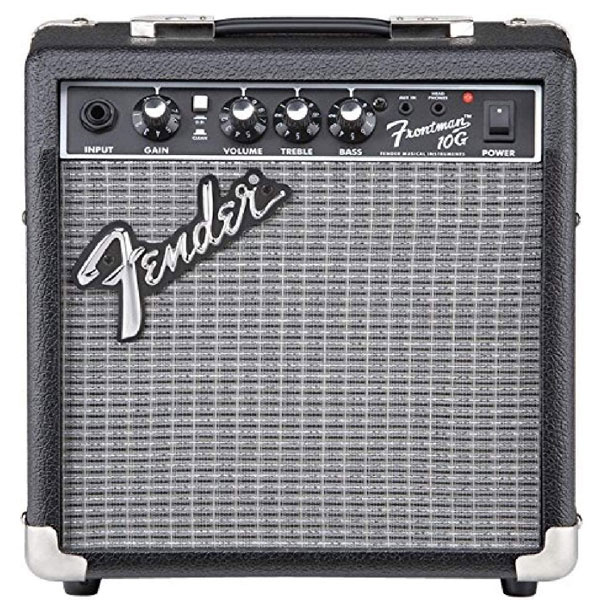
| Estimated Price | $90 |
| Connectivity | 1 x ¼-inch guitar input, 1 x 1/8-inch aux input, 1 x 1/8-inch headphone output |
| Output Power | 10 watts |
| Speaker | 1 x 6-inch |
My Review: While we all know them for game-changing guitars, Fender’s line of small Frontman amps includes some of the company’s most successful products. As far as the cheapest amps go, the Frontman 10G model is more than a viable choice.
Along with a few other variants, this amp is fairly popular among beginners. Nonetheless, due to its compact size and simplicity, it can serve as a great bedroom practice amp for any guitar player.
Sure, the controls are fairly limiting, bringing only volume, gain, and a 2-band EQ. But what really impressed me is the quality of the distorted tone. Again, you can’t expect pro-level stuff within this price range, but the distortion is pretty tight. And depending on the gain intensity that you set on it, you can cover a lot of genres.
Additionally, you also get the standard 1/8-inch auxiliary input and a 1/8-inch headphone output.
Bottom Line: It’s a really simple amp, but we can’t help and appreciate its distorted tone. Other than that, it’s an amp that gets the job done for guitar players of all genres and skill levels.
3. Blackstar Fly 3
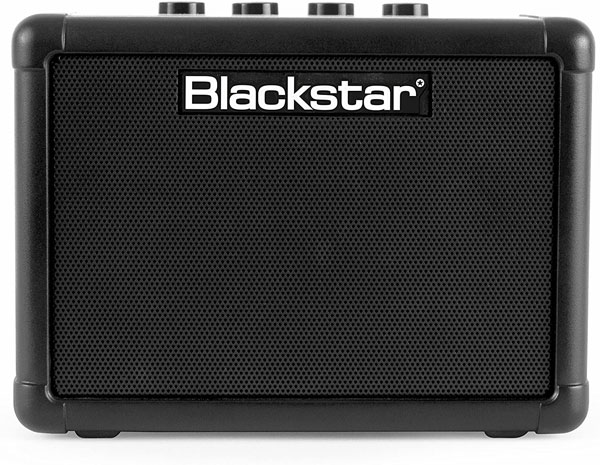
| Estimated Price | $80 |
| Connectivity | 1 x ¼-inch guitar input, 1 x 1/8-inch aux input, 1 x 1/8-inch headphone output, 1 x RJ45 jack |
| Output Power | 3 watts |
| Speaker | 1 x 3-inch |
My Review: Honestly, it was a tough choice between Blackstar’s Fly 3, Fender Frontman 10G, and Boss’ Katana Mini. While the Fly 3 is definitely not a worse amp by any means, it comes with only 3 watts of output power, which can make it somewhat limiting.
Nonetheless, we have a pretty potent little practice amp here. And, at the same time, it’s very easy to use. There are gain, volume, ISF, delay time, and delay level controls. Additionally, there’s an overdrive toggle switch.
While you’re most likely familiar with these controls, one really stands out. Instead of an EQ or a tone knob, there’s the so-called ISF feature. This lets you choose between traditionally “British” and “American” tones and everything in between.
Of course, it’s not like you’ll get a Marshall Super Lead tone, but it really makes things interesting. This is especially the case with overdriven settings.
We also have an auxiliary input and a cabinet simulated output. However, there’s also the RJ45 jack (the kind used for network cables) which is for Blackstar’s specialized extension cabinets.
Honestly, extending a 3-watt amp with an additional 3-inch speaker cabinet seems like a weird idea. But at the same time, it’s a pretty interesting concept to play around with.
Bottom Line: Aside from the headphone output, which can serve as a cabinet emulated output for PA systems, the Fly 3 has one very interesting feature. We’re talking about the company’s special ISF control. It not only simplifies what would otherwise be a 3-band EQ but also brings unique tone-shaping options.
4. Orange Crush 12
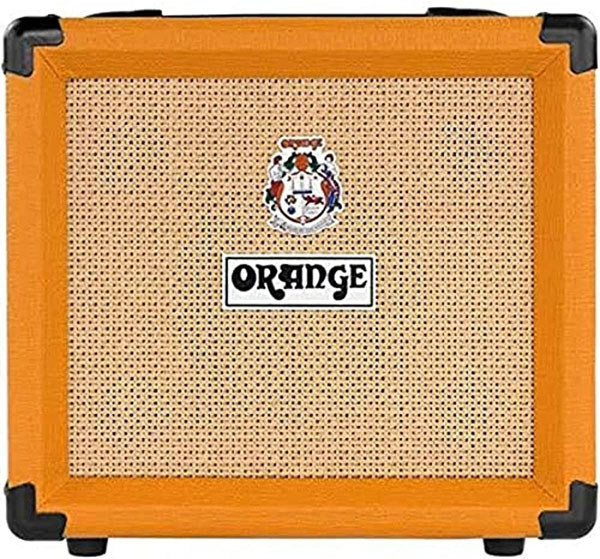
| Estimated Price | $100 |
| Connectivity | 1 x ¼-inch instrument input, 1 x ¼-inch headphone output |
| Output Power | 12 watts |
| Speaker | 1 x 6-inch |
My Review: Orange amps are a touchy subject. While we can’t ever deny their greatness, they’re for guitar players who have a very specific taste. Their tone is “fuzzy” and “grainy,” yet it brings serious heaviness into the sonic equation.
This is what we can say about the Crush 12 amp, which packs 12 watts of output power and a 6-inch speaker. If you want a heavy old-school tone with a nice punch and a very reasonable price tag, this is the amp that you’re looking for.
It’s a single-channel practice amp that comes with an additional overdrive intensity control. Then we also have all the other standard features, including the headphone output.
However, comparable to the previous two amps, this one also comes with a cabinet simulator. But here we have Orange’s own CabSim circuitry that emulates Orange’s 4×12 cabinets.
Bottom Line: As mentioned, Orange amps are very specific. Nonetheless, Orange Crush 12 is a great option if you want something small, cheap, and heavy. Plus, you get 12 watts of power which can be used in studio or even some live settings.
The CabSim feature has a lot of practical value. Sure, there’s the expected option, to use the output for headphones. But at the same time, you can even plug it directly into a PA system or a mixer and get a realistic guitar tone.
Sure, it will cut the amp’s speaker off. But, at the same time, you can have a practice amp that you can take for some live gigs as well. In my honest opinion, the CabSim circuitry puts it way ahead of most of the amps in this price range or power rating.
5. Vox Pathfinder 10
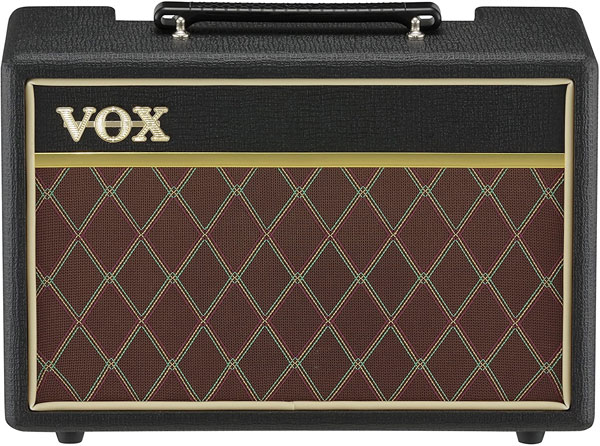
| Estimated Price | $80 |
| Connectivity | 1 x ¼-inch instrument input, 1 x ¼-inch headphone/line output |
| Output Power | 10 watts |
| Speaker | 6.5 inches |
My Review: Vox is one of the “safest” brands on the market, meaning that you can’t really go wrong with them. If you want a safe bet and a good deal for the price within this sub-100 category, we’d recommend Vox’s Pathfinder 10 model.
You have all the essentials that you need here. Aside from Vox’s classic visual design, you get a very simple amp with 10 watts of output power, a single 6.5-inch speaker, and a single channel with clean and overdriven modes.
There’s also the 3-band equalizer, but the tone always seems to be slightly more high-end-oriented. On the right-hand side, we can also find its ¼-inch output for headphones or anything else. While it’s not a specialized cabinet emulator, you can get some pretty great tones with it through a PA system.
Bottom Line: Simplicity, functionality, great tone, and its compact design make it a viable choice. Sure, it may be a bit too bright for some players. But this amp really takes a serious punch at its output power and value.
6. Danelectro N-10 Honeytone
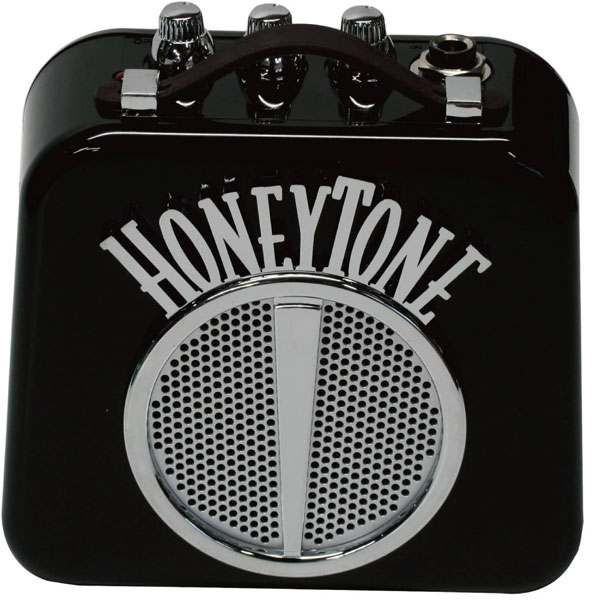
| Estimated Price | $30 |
| Connectivity | 1 x ¼-inch instrument input, 1/8-inch headphone output |
| Output Power | 1.5 watts |
| Speaker | 1 x 2.5-inch |
My Review: Sure, we have an abundance of these practice amps, some are even battery powered. But where are all those super-small amps that you can put in your gig bag? If this is something you’re looking for, then Danelectro’s N-10 Honeytone would be worth checking out.
Now, there are three important advantages of this practice amp. Firstly, it’s pretty compact, 5 by 5.25 by 2.25 inches. Secondly, it comes with only 1.5 watts of output power. And, third, it’s super cheap.
Sure, you have the headphone output, but I’m wondering whether it even makes sense to have one. The amp is quiet enough for simple bedroom practice.
Other than that, it’s extremely simple to use with only tone (treble roll-off), volume, and drive controls. It’s also powered either through a 9-volt battery or with a 9-volt adapter.
It isn’t exactly the prettiest-looking one, although that’s subjective. And, in all honesty, it feels a bit flimsy. But considering its price, you can’t get a better deal for a super-cheap budget-friendly practice amp. At this price, it gets the job done.
Bottom Line: With all this said, I’d recommend this amp to anyone looking for a cheap, simple, and quiet solution. Sure, the build quality could be up a notch. But it’s so cheap that you can buy a spare one at the same time. It’s a better alternative to an otherwise overpriced (yes, I won’t sugarcoat it) Marshall MS-2 amp.
7. Monoprice 611720
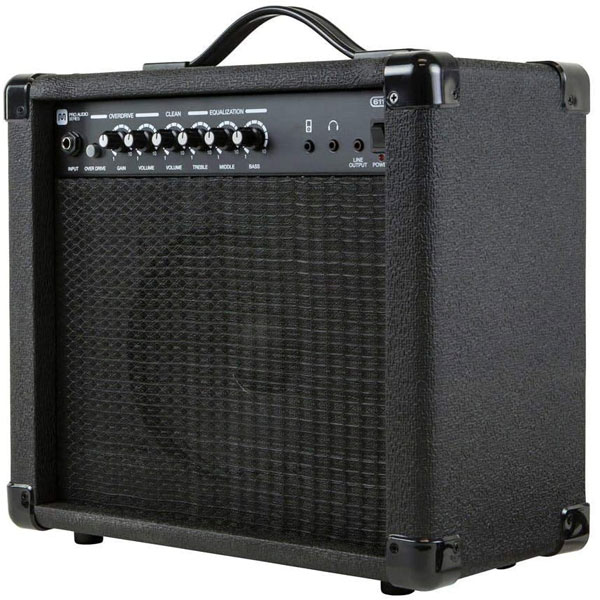
| Estimated Price | $85 |
| Connectivity | 1 x ¼-inch instrument input, 1/8-inch aux input, 1/8-inch headphone output, 1/8-inch line output |
| Output Power | 20 watts |
| Speaker | 1 x 8-inch |
My Review: In all honesty, I’m not sure how Monoprice gets away with these prices. To those who don’t know, they’re a generic-brand consumer electronics company that, among many things, also makes guitar amps. They got a lot of attention for their super-cheap tube amps, and here we’re looking at their cheap 20-watt solid-state amp.
The 611720 model comes with clean and overdrive modes. We have a master EQ, clean volume, and overdriven volume and drive controls. Essentially, it gets you covered for everything.
Sure, it doesn’t have any onboard effects, but with 20 watts of output power at this price, you get a pretty great deal. You can easily use it for live gigs.
What’s more, it even comes with an aux input, headphone output, and a line output for hi-fi or PA systems. You get a fully functional gig-ready amp that can also serve you well for practice sessions.
And, most importantly, the amp actually sounds pretty decent. The only downside to Monoprice is that they’re a generic brand so you won’t be that cool among other guitar players. But all jokes aside, surprisingly great amp at this price.
Bottom Line: While it’s not the cheapest one on the list, it certainly counts as a budget option. Mainly because you get a fully functional gig-ready 20-watt amp at such a low price. If you want something to get you covered both for bedroom practices and live shows, and still save money, Monoprice’s 611720 definitely won’t disappoint you.
8. Peavey Backstage II
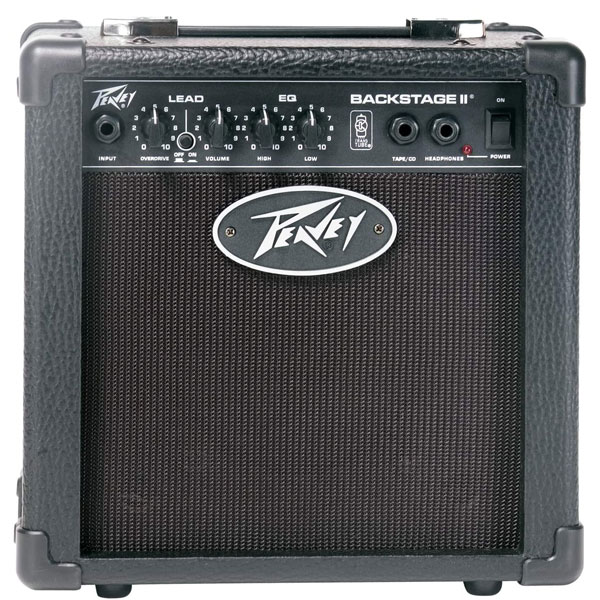
| Estimated Price | $100 |
| Connectivity | 1 x ¼-inch instrument input, 1 x ¼-inch aux input, 1 x ¼-inch headphone output |
| Output Power | 10 watts |
| Speaker | 1 x 6.5-inch |
My Review: It goes without saying that you can’t expect to have a tube-driven amp below the $100 mark. However, there are ways to work around this and have at least a portion of that sweet, warm and dynamically responsive tone. Peavey did this with their Backstage II combo amp.
The secret is in the specially designed preamp circuitry. It has the so-called “TransTube” technology. Now, it won’t magically turn it into a tube amp, especially not at this price level. But the results are still pretty awesome.
Backstage II comes with two channels, clean and overdriven. The controls are very simple, featuring a 2-band EQ, master volume, overdrive level, and a channel toggle switch. But despite its simplicity, you can create anything from sparkling cleans to heavier leads.
The most interesting thing here is that you can get those crunchy bluesy tones with some serious dynamic response. You don’t really find this with many solid-state amps unless there’s some intricate digital amp modeling involved. And even then, this little Peavey outperforms most of them.
The headphone output is also useful, but I’m not certain how well it would serve you as an emulated cabinet output for PA systems. But I’m probably being a bit nitpicky since this is a fairly good amp.
Bottom Line: Peavey’s Backstage II is a great option if you love tube amps but can’t, or won’t, spend money on them. Primarily, I really liked how the crunchy blues tones sounded on it, so this would be its highlight.
Despite only having 10 watts of output power, you can actually use it for live gigs if you mic it up. It’s a pretty impressive one considering the price.
9. Donner M-3
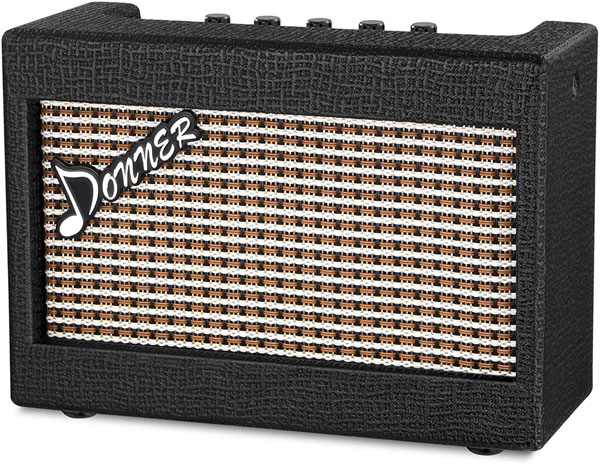
| Estimated Price | $50 |
| Connectivity | 1 x ¼-inch instrument input, 1 x 1/8-inch aux input, 1 x 1/8-inch headphone output |
| Output Power | 3 watts |
| Speaker | 1 x 3-inch |
My Review: Okay, I get it. There might be some weird reactions to having a Donner amp here on the list. The brand might get some bad rep, but this is usually all based on their super low prices.
But that’s the whole point here. Donner makes some pretty decent stuff for the price. While certainly not pro-tier stuff, the company’s M-3 guitar amp can deliver a pretty good punch for a practice amp.
What I really liked about it is that it’s compact and light. Additionally, aside from a 9-volt adapter, you can power it using AA batteries. The consumption, however, might not be that effective. So the battery life might not be as long compared to some other amps here, but it does the trick.
On the amp’s top side, we can find a 3-band EQ, as well as volume and drive level controls. The distortion can be turned on with a small switch between the volume and drive knobs. And it’s a sharp and “raspy” kind of distortion with a lot of harmonic content.
Another thing that I’d like to mention is the overall build quality. Although light, you can notice that they’ve given a lot of attention to the overall design.
Bottom Line: Being a practice amp, you’ll be more than satisfied with it. With a pretty reasonable price tag, it’s more than a great choice for anyone looking for a desktop amp. With its aux input and headphone output, it also becomes a great amp for jamming.
And finally, its size, weight, and build quality make it an awesome travel amp. Being so compact and light, you can easily put it in any average travel bag.
10. Fender MD-20 Mini Deluxe
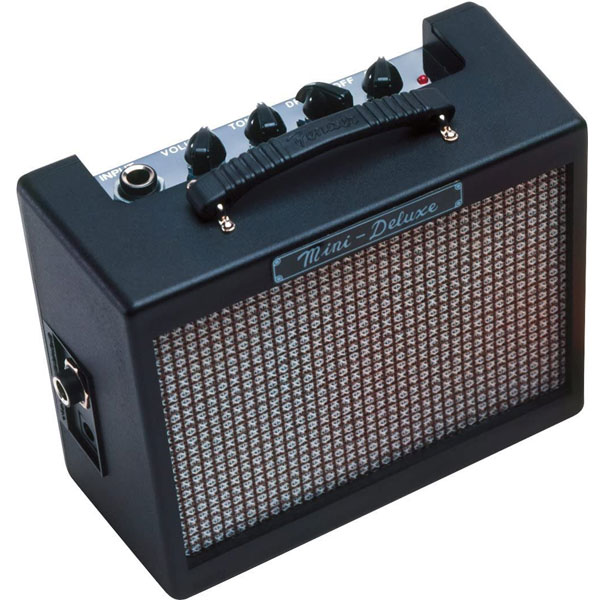
| Estimated Price | $45 |
| Connectivity | 1 x ¼-inch instrument input |
| Output Power | 2 watts |
| Speaker | 1 x 2-inch |
My Review: Knowing how awesome Fender’s stuff is, it’s hard not to mention at least one more of their cheap amps here. If you really want a good compact practice amp that you can take anywhere with you, and still keep all of the great sonic qualities, then their MD-20, also known as the Mini Deluxe, is a great choice.
And it’s as simple as it gets. We have the standard ¼-inch instrument input, an on-off switch, and three basic controls. After all, what more do you need on a practice amp other than volume, tone, and drive intensity controls?
It all goes through the amp’s 2-inch speakers, delivering a total of 2 watts of output power. Sure, it’s not much. But you can power it through a single 9-volt battery and get hours of playing time at an average volume level.
Bottom Line: Again, we have an amp that I’d like to compare to Marshall’s very popular MS-2. And honestly, once again, I can’t help but notice a way better combination of price and qualities.
Additionally, it even comes with some of Fender’s easily recognizable visual traits. While certainly not a priority, these traits make it a cute little amp. We could say that you get a full package in a compact-sized package.
11. Orange Crush Mini
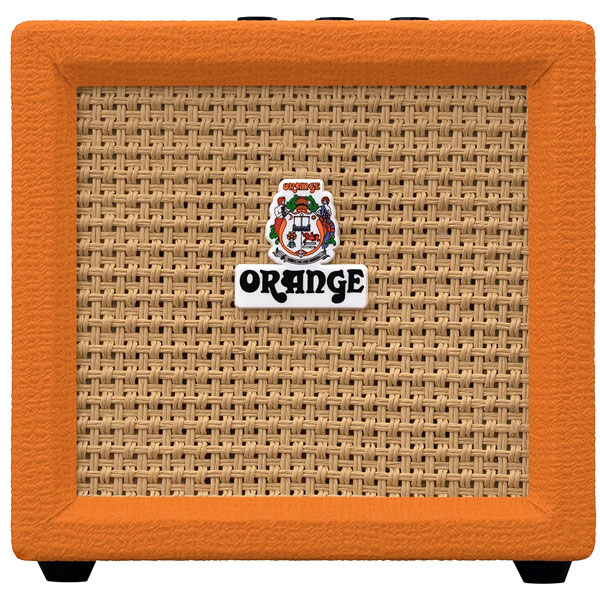
| Estimated Price | $60 |
| Connectivity | 1 x ¼-inch instrument input, 1 x 1/8-inch headphone output |
| Output Power | 3 watts |
| Speaker | 1 x 4-inch |
My Review: Again, Orange amps might not be for everyone’s taste. Their fuzzy overtones certainly make them a good choice for some musical styles. However, when it comes to the sub-100-dollar category, the company has this compact and useful Crush Mini model.
Essentially, Orange Amplification managed to put their classic Crush series circuitry in a small-sized device. You can notice a portion of their classic tone in this little amp. But then again, it’s still good and versatile enough to be used for various other stuff other than heavier (or psychedelic) music where fuzzy tones are favored over “tight” ones.
The amp’s interface is super simple. We have the standard combination of volume, tone, and gain. However, they’re represented with the company’s classic symbols, which some users might find confusing at first.
Aside from the instrument input, we can also find a 1/8-inch output for headphones. It gives an interesting twist to the tone if you play it through headphones, slightly emulating Orange’s classic amps and cabinets.
Finally, you also have an onboard tuner on the amp. This is actually a pretty useful little tool that can really come in handy. Sure, it’s crammed right there on this small interface, but it gets the job done.
Bottom Line: Although having only 3 watts, it’s obvious that Orange’s Crush Mini is designed as a practice amp for the lovers of the company’s classic amps. But honestly, it gets the job done for anyone else as well.
Clean tones have no unwanted “dirt” on them, although they’re a bit “thin,” but you expect that from such a small amp in a plastic housing. Additionally, having a headphone output and a tuner is also pretty neat.
I’d say that Orange Crush Mini is one of the best backstage amps for warmups. Due to its sharper tone, it can cut through the noise easily, which can be pretty useful in such a setting.
12. LyxPro AGL-20
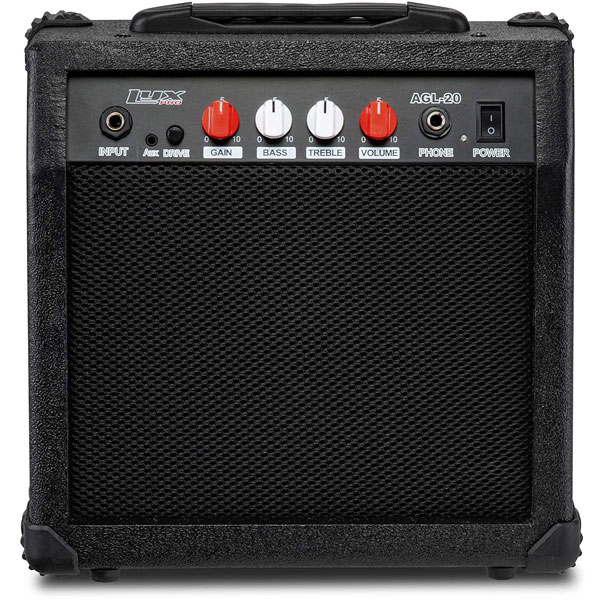
| Estimated Price | $55 |
| Connectivity | 1 x ¼-inch instrument input, 1 x ¼-inch headphone output, 1 x 1/8-inch auxiliary input |
| Output Power | 20 watts |
| Speaker | 8 inches |
My Review: LyxPro is a brand similar to Danelectro and Monoprice that we mentioned. They also produce those budget-friendly amps that get the job done for practices and rehearsals, as well as some cheap entry-level guitars.
Here we have their 20-watt amp, the AGL-20 model. The amp can be loud enough even for a live gig. But to be fully honest with you, it wouldn’t exactly be my first choice for this purpose. It’s not a bad amp, especially not within its price category. But you need to know that this is a low-budget amp, so you won’t really get the best possible tones on higher gain and higher volume settings. Nonetheless, it’s an amp worth every penny.
Other than that, we have a very simple layout on the front panel. There’s the 2-band EQ, the volume knob, the gain control, and the toggle switch for the distortion. We also have the headphone output with a ¼-inch jack and a standard 1/8-inch aux output.
Bottom Line: While definitely not a prestigious one, LyxPro AGL-20 is a pretty decent amplifier. As mentioned, it can get you covered for practice sessions, jam sessions, and rehearsals.
And yes, you can definitely use it for live gigs or studio work. But despite its power rating, I’m not exactly optimistic about the tone quality at higher volume and higher gain settings.
Of course, the headphone output is useful, as well as the aux input. But having the ¼-inch headphone output, it makes it simpler to use it in other applications. For instance, you can play around and try to connect it directly to a PA system. Although this would automatically cut the speaker off, you can still get the fairly realistic guitar tone through a mixer.
Maybe I was a little too hard on it in some aspects, but AGL-20 is definitely worth checking out if you’re building a budget rig. Just don’t get your expectations too high.
13. Joyo Audio MA-10E
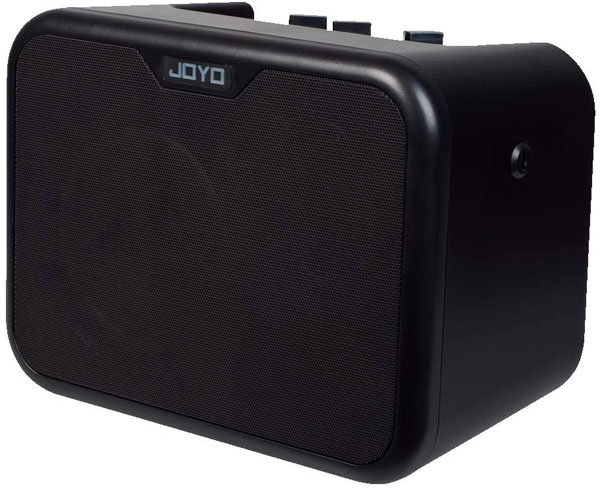
| Estimated Price | $45 |
| Connectivity | 1 x ¼-inch instrument input, 1 x 1/8-inch headphone output, 1 x 1/8-inch auxiliary input |
| Output Power | 10 watts |
| Speaker | 5 inches |
My Review: Once again, we’re going into one of those cheaper brands. But honestly, there are a few things that would differentiate Joyo Audio from some other brands. No disrespect to LyxPro, but I’d rather go with something like Joyo’s MA-10E within this price range.
Sure, the amp has half the output power. But at the same time, it’s significantly smaller, easier to use, and it even has a pretty decent tone for a plastic amp. It’s packed with one 5-inch speaker which does a fairly good job at covering the most important guitar tone qualities that you’ll need for practice or jam sessions.
We’re once again looking at an amp with a simple control interface. There are only three knobs and one switch on the top panel. Volume, tone, and gain, along with a distortion toggle switch – the basic setting that you’ll need for practice sessions.
Additionally, we have two 1/8-inch jacks. It’s the classic formation, one used as a headphone output and the other one as the auxiliary input. Other than that, we have a power switch on its backside. And, above all, you can power it either with a 9-volt adapter or using six AA (standard-sized) 1.5-volt batteries. The playing time with batteries won’t be super impressive, but you can get some decent playing time with quality batteries. We’re talking about three to four hours.
Bottom Line: I’ve been familiar with Joyo Audio for quite a while now. They have some surprisingly awesome pedals and other great products in their arsenal. And witnessing how well their MA-10E amp works wasn’t much of a surprise.
Of course, we’re still talking about practice amps. Although not super functional, bearing the three basic knobs, you can still get a lot of things going with it. There are enough of those punchy mids in the mix, both with clean and distorted modes. Whether it’s home practicing or backstage use, Joyo’s MA-10E will get you fully covered.
14. Sawtooth 10-Watt Amp
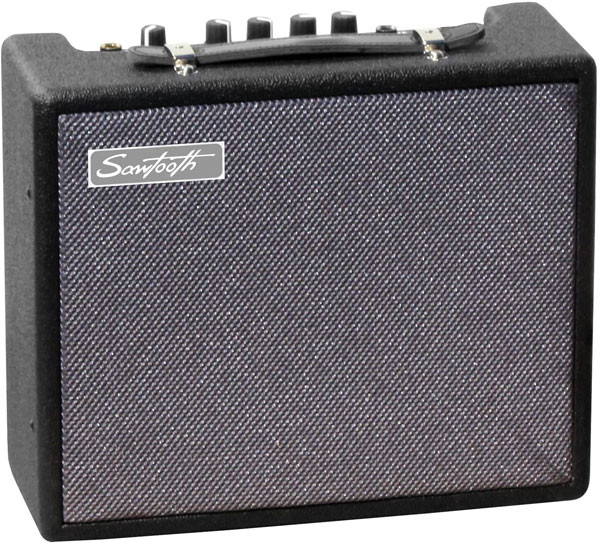
| Estimated Price | $60 |
| Connectivity | 1 x ¼-inch instrument input, 1 x ¼-inch headphone output |
| Output Power | 10 watts |
| Speaker | 6.5 inches |
My Review: Another small amp below the $100 mark I wanted to take a closer look at is made by Sawtooth. They simply named it a “10-Watt Amp.” It’s not very inventive, obviously, and it does feel a bit discouraging at first. But in reality, we have a pretty decent little 10-watt amp on our hands.
There’s one advantage to it, at least compared to most of the other cheap amps. As you might notice, most of these 10-watt amps come with smaller speakers and smaller plastic casings. On the other hand, this one comes with a 6.5-inch speaker.
Sure, this doesn’t actually make the amp’s output stronger and louder. But on the other hand, it definitely affects the tone quality. Compared to the small plastic amps, which are usually what you find within this price range, you get a more conventional kind of sound.
This Sawtooth amp is also fairly simple to use, and yet it brings some versatility. For an amp that has standard controls – a 3-band EQ, volume, and drive, as well as the distortion switch – I was able to get a few different things going on.
Finally, we also have a headphone output. It’s not like some specially-designed cabinet simulator output, but it can still work pretty well, be it silent practicing or going straight into a mixing board.
Bottom Line: Having a cheap 10-watt amp with a slightly larger speaker has its advantages. This comes with a better tone. However, there’s no option for battery-powered operation.
But if you’re looking for a fairly cheap amp with enough power and a decent tone, this is a good trade-off. It’s still cheaper than some other amps that we mentioned here, like the Vox Pathfinder or Orange Crush 12. But it’s still a worthy competition.
Overall, it’s a pretty good amp within its price range. You can’t really go wrong with it if you’re looking for something cheap and reliable for home use.
Choosing the Right Amp Under $100 for Your Needs
Looking at the list, it’s obvious that you can find some pretty awesome sub-100 amps on the market. However, there are a few things you’ll need to bear in mind before making your purchase. After all, everyone has different needs and wants when it comes to guitar amps.
Don’t Expect a “Full Package” Within This Price Limit
The main thing to know is that you can’t have a pro-level amp below the $100 mark. Sure, you’ll have something good like Boss Katana Mini. But on the other hand, it doesn’t have the output power.
Then you have an amp like LyxPro AGL-20 that has enough output power but lacks features and top-tier tone quality.
In short – you can’t have it all. With this said, you need to know what you’re looking for within this price range. Is it just a home and backstage practice amp, or something that you can use for smaller live shows, or maybe even studio sessions?
Tone
The amps that are just below the $100 mark will usually have a much better tone quality. And while you can’t expect a tube amp for this price, or some lavish effects and digital modeling, some are finding ways to compensate. One such example is Peavey’s Backstage II amp with the company’s so-called “TransTube” technology.
No matter the wattage, the general rule is that the smaller the amp and the speaker, the “thinner” the tone gets. The same goes for those that are put in flimsier plastic casings. This, of course, doesn’t mean they sound bad, it’s just that they’re noticeably brighter-sounding.
In most cases, those who are looking for a sub-100-dollar amp need something for home use. So the tone quality should be good enough not to ruin your practice and jam sessions. If you need more than just that, then you’ll need to try these individual amplifiers out.
Additional Features
If you need just simple practice, then basic controls will do (the essential volume, drive, and tone controls). All of these amps come with distortion, be it as a separate channel or as a switchable effect.
You can also notice that they come with headphone outputs, that can also be used as outputs for PA or home entertainment systems. If this is something that works for you, look for amps that have simulated cabinet outputs, like Orange’s Crush 12.
Additionally, these cheap amps can come with auxiliary inputs that you can use for backing tracks. Other useful tools can also include tuners or an effect or two, usually just a delay or reverb.
Power Options
And, finally, you should also be thinking of power options. Smaller amps within this price limit, even up to 10 watts of output power, can work on batteries.
These are usually multiple AA batteries or a single 9-volt battery, just like the one that can power a standard effects pedal. Of course, standard 9-volt adapters are also used for these battery-powered amps.
Larger amps in this category, usually those that have 10 watts or more, are equipped with their power unit and require to be plugged in. Most commonly, this is done with a standard C13 power cord.
The advantage of battery-powered amps is that you can take them anywhere with you. The advantage of bigger amps is that they usually come with a bigger speaker and, in most cases, a better tone quality.

My name is Chris and I’ve had a passion for music and guitars for as long as I can remember. I started this website with some of my friends who are musicians, music teachers, gear heads, and music enthusiasts so we could provide high-quality guitar and music-related content.
I’ve been playing guitar since I was 13 years old and am an avid collector. Amps, pedals, guitars, bass, drums, microphones, studio, and recording gear, I love it all.
I was born and raised in Western Pennsylvania. My background is in Electrical Engineering, earning a Bachelor’s degree from Youngstown State University. With my engineering experience, I’ve developed as a designer of guitar amplifiers and effects. A true passion of mine, I’ve designed, built, and repaired a wide range of guitar amps and electronics. Here at the Guitar Lobby, our aim is to share our passion for Music and gear with the rest of the music community.
